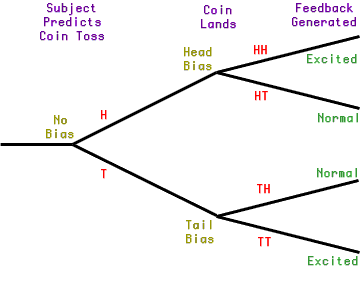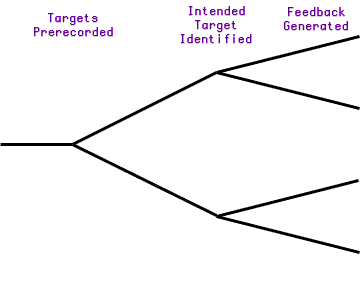 |
|
Branching Many World Timeline |
Up to this point, I have been perverting quantum mechanics. The quantum mechanics people have many observations, and equations that match the equations very well, and headaches when they try to figure out the meaning of the equations. As the physicists have it stuck in their minds that the past causes the future, they have noted that quantum physics leads to assorted paradoxes, but have not been able to resolve them. Assuming reverse time causality might clear up some existing paradoxes, but will invite others.
We now switch over the realm of parapsychology. The psi researchers have a phenomenon, sort of, but the conformation of the phenomenon is relatively weak. They have no equations explaining the effects they can sometimes observe. They have no good theory that accounts for their observations. The theories that they have don't mesh very well with main line physics. In fact, the phenomena itself is considered far enough out of line with main line physics that many want to deny experimental results rather than reexamine their theories.
But even the skeptics have admitted that the core highly controlled laboratory experiments look valid. Human psi subjects seem able to predict random events (extra sensory perception, or ESP), and alter the probability of random events (psychokinesis, or PK).
The difference between laboratory ESP and PK are small. One needs a random target generator (RTG). One can either predict the random target, or attempt to alter or bias the random target. Rolling dice, flipping coins and shuffling cards are some random targets used in older experiments. Newer experiments might get fancier, using radioactive decay or electronics to generate harder to rig random effects. If one is attempting to predict the RTG, the experiment might be better called ESP. If one is attempting to influence the RTG away from a random result, it might be best described as PK.
While a few special subjects can beat the odds absurdly, many of these special subjects cheat. Many psi researchers or theorists, including myself, prefer to deal with ordinary volunteers producing smaller but still significant probability shifts. Such experiments tend to produce a very small alteration off random. If one performs enough experiments, the odds build up.
Let us assume an ESP coin flip experiment. The subject predicts the flip. The flip is made. Hit or miss is determined. Assuming that living humans are somehow driven by quantum level effects, and assuming for the moment a Many Worlds perspective, four groups of alternate realities exist after the experiment. The subject could have predicted heads or tails. The coin could have landed heads or tails. Listing prediction then result, the outcomes might be HH, HT, TH, and TT.
Lets make a bunch of simplifying assumptions. Not all of them will be precisely true. The intent is to make people consider and refine, not to peg a precise wording.
Living animals in the course of normal activity generate many molecular level interactions at the quantum level. Many of these leave traces in the body, and thus might be considered a collapse in a Copenhagen theory. Under Many Worlds theory, the normal process of living results in the creation of many alternate realities.
The rate of generation of alternate realities is not constant. An individual burning more calories, or thinking deeper thoughts, or increasing his or her metabolism, will split off alternate realities at a higher rate than an individual at rest.
Now we take the big leap. Each alternate reality has roughly as many electrons in phase as any other reality. At a particle level, if dropping a photon would frequently put an electron into phase with itself repeatedly, the photon would drop. I shall suggest that a future with a particle in phase with itself is more probable than a particle where the particle never comes into phase. Thus, the probabilities of the universe get warped such that particles get to reinforce one another or their alternate selves. If we assume that each universe on average has roughly as many particles in phase, if an event causes the creation of more universes, that event would become more probable.
Lets assume that sometimes, if a subject predicts heads, and a heads comes up, the person gets excited. Excitement results in metabolism increase. Metabolism increase results in more collapse events, more alternate universes. Thus, the results TT and HH, resulting in emotion and metabolism, become slightly more probable than TH or HT.
 |
|
Branching Many World Timeline |
The above coin flip is a fairly traditional ESP experiment. Helmut Schmidt once did a PK experiment using electronics to generate the random number. He told the subject to attempt to alter a sound. The tone was produced by random electronics. Some subjects were listening directly to the random sound generator.
Another group of subjects were listening to a tape recording made by the random number generator, a recording made the day before the test. The subjects didn't know it, but they were trying to modify the contents of a tape. They succeeded. The efforts of psi subjects were able to alter the performance of a random target generator on the day before.
This was intended as a control. Schmidt, thinking he knew how about causality, anticipated the subjects would not be able to alter pre recorded targets. Instead, he developed a very strange evidence of reverse time causality. The thoughts of someone on day X seemed able to effect the performance of a device on day X 1.
 |
|
If the subject can select the influence he is going to exert, No bias at first branch point? To maximize bias at first branch point, intended targets must be the same for all future time lines. |
Schmidt then hypothesized that psi must include the possibility of a backwards in time effect. Once the subject realizes a hit occurred, some backwards in time feedback effect is sent backwards in time to meddle with past probabilities. He was unable to clearly suggest the nature of the feedback.
This paper proposes the nature of the backward in time effect. When the subject observes a hit, metabolism increases, the number of alternate realities increases. While this feedback mechanism is best understood using Many Worlds, not Copenhagen, the structure of the theory is quite similar to prior "observation theories" based on Copenhagen, and complies with Schmidt's Model.
 |
|
Copenhagen style single time line. Denial of the Many Worlds oversimplifies the model for Retrocausal feedback. If one doesn't look at the timelines branching, how can one see a bias in the branching of the timelines? |
 |
Many Worlds - Single
Particle Interference - Orbitals |